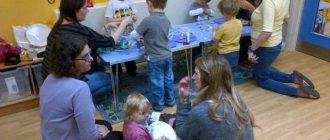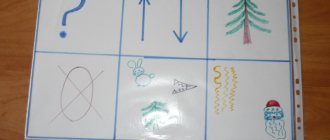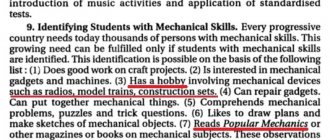Pedagogical Council "Modern pedagogical technologies in preschool institutions"
Currently, teaching staff of preschool educational institutions are intensively introducing innovative technologies into their work. Therefore, the main task of preschool teachers is to choose methods and forms of organizing work with children, innovative pedagogical technologies that optimally correspond to the goal of personal development. Many technologies have quite a lot of similarities in their goals, content, methods and means used, and based on these common features they can solve the problem of forming a “competent personality” in accordance with the targets outlined in the Standard.
A fundamentally important aspect in pedagogical technology is the child’s position in the educational process, the attitude of adults towards the child. When communicating with children, an adult adheres to the position: “Not next to him, not above him, but together!” Its goal is to promote the development of the child as an individual.
Today we will talk about educational technologies and their effective use in preschool institutions.
You and I will be builders and we will build a house under the name, and we will give the name of the house when we resolve all the issues of our council.
To begin construction, the site must be cleared. The letters were scattered on it; they had to be assembled into a word.
This word includes methods, techniques, a sequence of operations and procedures; it is closely related to the means, equipment, materials used, or it is clear and unambiguous knowledge (usually in the form of a set of rules or an algorithm) that allows one to obtain the desired final result from the initial components ( technology).
Game "Collect the word."
The site for the construction of a house consists of the main word - technology. The foundation of our house will begin to build and consolidate our knowledge about modern educational technologies in a preschool educational organization, the senior teacher of the preschool educational institution “Modern educational technologies in the context of the Federal State Educational Standard.”
Let's review what the term “technology” itself means.
Technology
comes from the Greek words for "skill, art" and "law, science" - this is
the science of craftsmanship.
The core of any technology: goal - means - rules for their use - result.
Pedagogical t
technology functions both as a science that studies and designs the most rational way of learning, and as a system of algorithms, methods and results of activities, and as a real process of teaching and education.
Pedagogical technology
is a holistic, scientifically based project of a certain pedagogical system from its theoretical concept to implementation in educational practice, reflecting the procedural side of training and education and covering their goals and content. Forms, methods, means, results and conditions of their organization.
Pedagogical Council "Innovative technologies in preschool educational institutions" methodological development on the topic
Pedagogical Council
"Innovative technologies in preschool educational institutions"
Goals:
- To clarify teachers’ ideas about pedagogical technologies, about innovative technologies of teaching and upbringing in a preschool institution;
- Introduce teachers to some modern technologies of preschool education;
- To promote the formation of motivation to use innovations in teaching activities.
Preliminary work:
1) A survey of preschool teachers on the question: “What innovations have you used over the past 5 years? (separately by year";
2) Testing of teachers:
a) a method for assessing the level of creative potential of an individual (Fetiskin N.P. Socio-psychological diagnostics of the development of the individual and small groups / N.P. Fetiskin, V.V. Kozlov. - M.: Publishing House of the Institute of Psychotherapy, 2002. - 490 With.);
b) methods for measuring rigidity (Raigorodsky D.Ya. Practical psychodiagnostics. Methods and tests: textbook / D.Ya. Raigorodsky. - Samara: BAKHRA-M, 2001. - 672 p.)
Pedagogical Council Plan:
- Theoretical information:
a) clarification of the concepts “method”, “technique”, “technology”, “innovation”, “innovative technology”;
b) social trends that contribute to the birth of innovations and their application in preschool education.
2) Analysis of data obtained during the survey and testing of preschool teachers.
3) Theoretical background: “Classification of innovative technologies.”
4) Presentation by preschool teachers of some modern technologies of preschool education.
Progress of the teachers' council:
I. Theoretical background.
1) Express survey of teachers.
Recently, when covering issues of modern preschool education, we constantly hear the terms: “pedagogical technology”, “modern technologies of preschool education”, “innovation”, “innovative technologies in preschool educational institutions”.
I ask you to raise your hands to those who understand well and have clear ideas about what pedagogical technology is and how it differs from the method and methodology, from the preschool education program, what innovative technologies exist in preschool education and what their essence is.
Depending on the result of the express survey:
- if there are many hands, the task of the pedagogical council is to update our ideas about innovative pedagogical technologies in preschool education and consider some of them in detail, get acquainted with the experience of our colleagues in using some innovative technologies in practice;
- if there are few hands, the task of the pedagogical council is to form ideas about innovative technologies of preschool education in general and get acquainted with some of them.
2) Work on clarifying the concepts of “method”, “technique”, “pedagogical technology”, “innovation”, “innovative technology”.
— Question to educators: “What is a method?”
(a method is a set of techniques and operations; a way to achieve a goal. For example, a teaching method is a way of joint activity between children and an adult, as a result of which children acquire knowledge, skills and abilities. The method of education is the interconnected activity of a teacher and students, aimed at achieving educational goals).
— Question to educators: “What is the methodology?” (a methodology is a set of methods that provide a solution to a specific problem. For example, a methodology for teaching literacy).
— Thus, schematically the relationship between methods and methodology can be expressed as follows (Appendix 1).
— Question for educators: “What is pedagogical technology?” (Pedagogical technology is an optimally selected set of methods, techniques, tools and an algorithm for their use to solve a clearly formulated problem).
What then is the difference between methodology and technology, if both are a certain set of methods and techniques for solving a specific problem?
Let's try to express the relationships between method, methodology and technology schematically (Appendix 2).
The essential features of pedagogical technology are (Appendix 3):
- Initial detailed information about the condition of each child;
- Clear logic and consistency of rules;
- It is always represented by stages of activity, each of which has its own goal. The first stage of any technology is always the diagnostic stage;
- Monitoring the achievement of results (from stage to stage). Only when children achieve the result does the transition to the next stage occur;
- Detailed detail, strict algorithm;
- Detailed definition of the final result. Guaranteed receipt of the planned result.
The essence of technology is methodology.
— Thus, the differences between the method, methodology and technology are (Appendix 4):
- A method is a set of techniques; methodology is a set of methods; technology is an optimal set of methods and means;
- Methodology and technology differ in the initial object: for the method it is an “average” child, for technology it is detailed information about the initial state of each child;
- Methodology and technology differ in the degree of elaboration and detail: methodology is the general direction of activity (for example, methods of teaching literacy), and technology is a detailed route with clearly indicated tools (for example, problem-based learning technology);
- Methodology and technology differ in content: methodology is the core, the essence of technology, its internal content, and technology is the tools around the core (methodology), which can change, speeding up processes, but the essence remains the same. (for example, a methodology for teaching literacy is an essence, and a set of the most effective techniques, an optimal algorithm, etc., together with a methodology, is a technology);
- The method and technology differ in the result: the outcome of the method is difficult to predict, because it depends on many factors (including the personal qualities of the teacher); the technology guarantees the achievement of the planned result; its application is less influenced by subjective factors due to detailed regulation of activities.
— Question for educators: “What place does the educational program of preschool education occupy among methodology and technology?” (The preschool education program determines the tasks and content of a preschooler’s education, and technology is the toolkit with which these tasks are solved. Technology is born from experience and can subsequently become the basis for creating a program).
The location of the preschool education program can be shown schematically (Appendix 5).
— Pedagogical technologies are classified into traditional and innovative (Appendix 6).
Traditional teaching technology is explanatory and illustrative teaching. The main methods are explanation combined with visualization, and the types of children's activities are listening and memorizing. This technology has its advantages and disadvantages.
Innovative technology contains an innovation component.
Innovation (innovation, change, renewal) is the activity of creating, mastering, using and disseminating something new.
Innovative technology is a new component for the education system.
Thus, innovation is not synonymous with innovative technology. We may use some kind of innovation in our work, but not necessarily innovative technology.
3) Social trends that promote the introduction of innovative technologies in preschool education.
— Why in recent years have we often begun to hear and use the concept of “innovative technology”? There are objective circumstances for this. Life itself dictates the need to use innovations and innovative technologies.
A number of social trends are identified that contribute to the creation and dissemination of innovative technologies. This:
- Requirements for the humanization of the educational process;
- High level of quality of education in connection with the implementation of FGT and Federal State Educational Standards;
- Focus on cultural and moral values;
- Competitive relations between educational institutions;
- Actively responding to the diversity of interests and needs of children and their parents.
Positive factors for using innovative technologies:
- Improving the quality of children's education;
- Growth of professional skills;
- Ability to carry out research activities;
- Increasing the competitiveness of the institution.
Difficulties in implementing innovative technologies:
- Increased complexity of work;
- Expanding the range of job responsibilities;
- Insufficient resources to implement innovations;
- Study overload.
II. Analysis of data obtained as a result of questionnaires and testing of teachers.
— Introducing teachers to data
— Rigidity is difficulty (up to complete inability) in changing the program of activity planned by a person in conditions that objectively require its restructuring. Rigidity - a tendency to preserve one’s attitudes, stereotypes, ways of thinking, inability to change personal point of view
— Professional mobility is the ability and readiness of an individual to quickly and successfully master new equipment and technology, to acquire the missing knowledge and skills that ensure the effectiveness of new career guidance activities.
— Conclusion based on the data.
III. Theoretical information
— Classification of innovative technologies (Appendix 7).
— The main innovative technologies used in preschool educational institutions are (these technologies are highlighted in the classification scheme in a different color):
- Health-saving technologies;
- Project-based learning technology;
- Technology of developmental education;
- Interactive technology, ICT technology;
- Gaming technology;
- Problem-based learning technology.
IV. Presentation by preschool teachers of some innovative technologies
— Speeches by teachers.
- List of literature on technologies - put on the table for reference.
References:
1. Atemaskina Yu.V. Modern pedagogical technologies in preschool educational institutions / Yu. V. 1. Atemaskina. – M.: Detstvo-Press, 2011. – 112 p.
2. Borodina O.N. Methodological support for innovative activities of preschool teachers / O. N. Borodina // Teacher of Kuzbass. – 2014. – No. 1 – P.8-11.
3. Panfilova A.P. Innovative pedagogical technologies. Active learning / A. P. Panfilova. – M.: Publishing house. , 2009. -192 p.
4. Pidkasisty P.I. Pedagogy: textbook / P. I. Pidkasisty. – M., 2006. – 608 p.
5. Raigorodsky D.Ya. Practical psychodiagnostics. Methods and tests: textbook / D.Ya. Raigorodsky. – Samara: BAKHRA-M, 2001. – 672 p.
6. Fetiskin N.P. Socio-psychological diagnostics of personality development and small groups / N.P. Fetiskin, V.V. Kozlov. – M.: Publishing House of the Institute of Psychotherapy, 2002. – 490 p.



